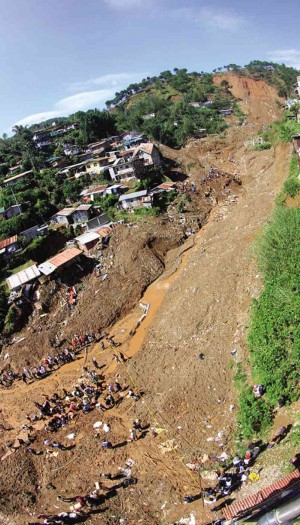Moving communities away from danger zones

RESCUERS dig through mud for survivors a day after a massive landslide wiped out a section of the community of Little Kibungan in La Trinidad, Benguet in 2009. EV ESPIRITU
What makes a danger zone even more dangerous? When people turn a blind eye to it until the worst scenario happens.
This was what happened in Benguet province’s capital town, La Trinidad, when Typhoon “Pepeng” dumped heavy rains that unleashed a landslide on the night of Oct. 8, 2009, killing 77 people, including children, in the community called Little Kibungan.
Years ago, Little Kibungan, a sleepy mountainside village in Barangay (village) Puguis, was declared a high risk area, but the local government allowed people to settle there against better judgment.
Then President Gloria Macapagal-Arroyo met with government experts and officials at the Presidential Mansion in Baguio City and resolved to move the residents out of the danger zone. In 2010, Arroyo issued a proclamation declaring a portion of a local university as the new home for survivors of the landslide that hit Little Kibungan.
Failed
Article continues after this advertisementFive years after the tragedy, the government has failed to relocate the survivors to a three-hectare reservation turned over by Benguet State University. Overlapping claims over the relocation site prevented the entire government machinery from undertaking its task, officials said.
Article continues after this advertisementAccording to Alex Uy, Cordillera director of the Office of Civil Defense (OCD), the Department of Public Works and Highways (DPWH) has completed a reinforcement wall protecting Little Kibungan from future landslides. Scientists have installed early warning devices, which people there heed religiously while the government resolves the land problem.
But Little Kibungan appears to illustrate a weakness in the government’s disaster risk management processes.
While the government has improved the response and rescue mechanisms from the national to the village levels, and has designed protocols for restoring calamity-damaged communities, very little seems to have been done to enforce the one solution to avoiding disasters: Move communities away from danger zones.
“Removing people out of harm’s way has always been our best option against disasters, but officials always find solutions to discourage that option. They’ll say, ‘It’s expensive,’ or they’ll cite the fact that we are moving them away from their livelihood. Here in the Cordillera, they will likely say we can’t move them from their ancestral lands,” said Rafael Valencia, president of 911 On-Call, a disaster response team in Baguio.
This ambivalence toward relocation prevails in every aspect of society today, Valencia said, from the “esteros” (estuaries) that induce flooding in Metro Manila to the squatter colonies that continue to rise on mountain slopes of Baguio.
The risk is borne first by the very people who chose to ignore government warnings and move into danger zones, Baguio Mayor Mauricio Domogan said. The government’s new task under an environment where extreme weather increases the risk of disasters is to make people aware that these are very real life-threatening hazards, he added.
Responsibility
But the national and local governments should also shoulder responsibility for the risk some people take, said Clarence Baguilat, former director of the Department of Environment and Natural Resources (DENR) in the Cordillera.
Local governments have the tools to identify critical areas, which could be exempted from settlements by their local land use plans, Baguilat said. They are also empowered by law to move people away from high-risk areas by demolishing houses built with no permits or by investing in communities far from danger zones.
Baguilat cited the Little Kibungan relocation project as an example of how political will could make or break a life-saving project.
Right after Arroyo issued Proclamation No. 2098 on June 22, 2010, her administration allocated funding and set aside as much as P70,000 for each family qualified for relocation to help them build new houses.
As of last count, the relocation site in Barangay Tawang would have hosted 184 home lots for the survivors, 115 of whom live in the heart of the danger zone.
But relocation work stalled almost as soon as the proclamation was released when the DENR observed a typographical error in the proclamation and had suggested correcting its technical description to reflect the area meant for the new Little Kibungan.
Months later, reports circulated that some families had asserted their claim over the site and had effectively frozen the process Arroyo herself had set in motion. In August 2011, the claimants, led by William Capuyan, urged President Aquino to nullify the proclamation.
Baguilat urged the agency to deny Capuyan’s petition “for lack of merit” and recommended that the proclamation declaring certain parcels of land in Barangay Tawang, La Trinidad, Benguet, be upheld and immediately implemented.
As of October 2012, it said, the agency’s land management service was still determining whether the donated lot was free of encumbrances.